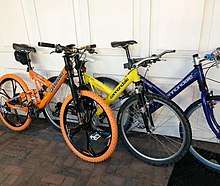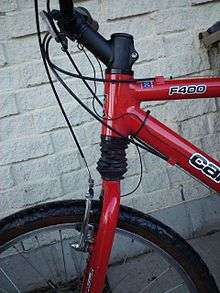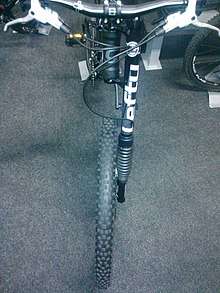Cannondale Bicycle Corporation
The Cannondale Bicycle Corporation is an American division of Canadian conglomerate Dorel Industries that supplies bicycles. It is headquartered in Wilton, Connecticut with manufacturing and assembly facilities in Taiwan.
| Subsidiary | |
| Industry | Bicycles |
| Founded | 1971 |
| Headquarters | Wilton, Connecticut, United States |
Key people | Peter Woods, CEO |
| Products | Bicycle and Related Components |
| Parent | Dorel |
| Website | cannondale |
History
The company was founded in 1971 by Joe Montgomery and Murdock MacGregor to manufacture precast concrete housing. Later Ron Davis came to Cannondale from CBS Laboratories where he was VP in charge of the development of microfilm reproduction. Ron, a polymath and a gifted mechanical designer/inventor, had ideas for an internal combustion engine that would use ammonia as fuel. Such a concept, if proved, could have far-reaching effects in warfare logistics and middle-eastern politics. Davis, with MacGregor as assistant, had some surprising success. They managed to duplicate and exceed results obtained by Allison Engine, then a division of General Motors. Faced with a commitment to invest a large amount of capital to take the project to a workable model installed in an automobile, Joe decided that the company should raise capital by developing and marketing other products that they had conceived. By now MacGregor and Davis had recruited two more CBS Laboratory alumni: John Wistrand, an award-winning Industrial Designer, and Jim Catrambone, a rising management star. A highly advanced air conditioner with no moving parts was a first effort.
Then Joe Montgomery, after a camping bike trip with his son, conceived the Bugger bicycle trailer. Ron Davis devised the under-seat hitch, a torsion spring made of Lexan. Wistrand designed the cloth bags and cargo carrier on the two models of trailers. Joe, in an effort repeated in numerous products, sourced the cloth components and ensured perfection in their manufacture. A trip to the Bicycle Show in New York was an eye opener. The team was besieged by bike dealers wanting to buy the bags. They bought trailers too but really wanted the bags. In less than six months Cannondale became the world's largest manufacturer of lightweight bicycle bags. Using a marketing plan devised by Montgomery, Cannondale swept across the US, securing orders from more than 2500 dealers in less than 20 months. They then used the infrastructure developed to produce the bags to enter the camping goods market with backpacks and tents. Regarding the Bugger trailer, although Cannondale's marketing department claimed to be unaware of the connotations of that name in British English, some were, nevertheless, exported to the UK.
Once fully immersed in the retail bicycle industry, Todd Patterson, another exceptional designer/inventor, came aboard and developed the process for jigging and welding aluminum bicycle frames. Cannondale became a serious manufacturer of bicycles.[1][2]
Today, Cannondale produces high-end bicycles, although they are no longer hand-made in the US. Many bicycle frame manufacturers use many materials such as steel or titanium, Cannondale specializes in aluminum and carbon fiber, a technology in which they were pioneers.
The name of the company was taken from the Cannondale Metro North train station in Wilton, Connecticut.[3] Another story as told in their 1983 catalog is that employee Pete Meyers was sent to order telephone service installation in 1970. When asked for the name of the business to be listed under, Meyers coined the name while looking at a rusty cannon inscribed "dale" and the sign on the Cannon railroad crossing.[4]
Ownership
Originally a privately held company, Cannondale became publicly held after a $22 million IPO in 1995.[5]
In the late 1990s Cannondale moved into the motorsports business, producing a line of off-road motorcycles and all-terrain vehicles. According to an interview with Cannondale Communications Director, Tom Armstrong, the company was unable to reduce the cost of their vehicles fast enough. As sales increased the company was losing money on each motorbike. This gap drove the company into bankruptcy protection on January 29, 2003.[6] Cannondale's full assets were then purchased at auction by Pegasus Capital Advisors fund Pegasus Partners II, L.P.[7][8] Pegasus sold off the motorsport division and supported the company's renewed focus on bicycle production.[9]
In February 2008, Dorel Industries, a Canada-based diversified consumer products company, announced the purchase of Cannondale from Pegasus Capital for approximately $200 million. Dorel also owns Pacific Cycle, a distributor of bicycles made in Taiwan and the People's Republic of China for sale under many historic U.S. cycle brands, including Schwinn, Mongoose, Roadmaster, and GT.
In April 2009 it was announced that all production would be transferred to Taiwan.[10]
Products
Bicycle frames
Cannondale began manufacturing aluminum racing and touring frames in 1983, with mountain bike frames added later. The earlier models sported oversized aluminum tubes for increased stiffness, resulting in frames that were super-stiff and super-efficient. Later, carbon fiber composite frames were developed.
Cannondale's bicycle frame components were made in its factory in Bedford, Pennsylvania, but are now made in multiple factories in Asia.
In 2009, Dorel Industries announced its intention to move all of Cannondale's bicycle manufacturing to factories in Asia by the end of 2010.
On January 23, 2014, Dorel Industries announced a restructuring of operations in its recreational/leisure segment. This resulted in the closure of its assembly and testing facility in Bedford, Pennsylvania. The Bedford plant, which at one point produced Cannondale’s midrange to high-end aluminum and aluminum/carbon fiber bikes, still handled some assembly, testing, quality control, and customer and technical services. Around 100 people were laid off.[11] The Bedford facility was shuttered in 2015.

CAAD design and manufacturing

The first road frame from Cannondale was produced in 1983. It sold for $350 and included the frame and fork. The fork was steel with helical reinforcement ribs inside the steel steering tube. The frame was recognizable by its oversized down tube and enlarged head tube. The seatstays and chainstays were ovalized to reduce flex. Unlike steel frames, there were no lugs: the aluminum tubes were mitered, hand welded, and then heat treated.
The first frames were available in two colors, red and white, and painted with DuPont Imron paint. Cannondale achieved the distinction of becoming the first high-volume producer of aluminum frames. Previously only steel frames were mass-produced, while aluminum frames were handmade in low volumes.
In 1992 Cannondale introduced the 2.8 series frame based on CAD (computer aided design) and finite element analysis to make a frame weighing only 2.8 lbs. The 2.8 series featured a tapered large diameter down tube, double-offset bottom-bracket cluster, ovalized top-tube, and double-butted seat tube to achieve the weight reduction. The same year the 1.25" Sub One all aluminum fork was introduced. [12] [13]
Cannondale marketed subsequent frames with the CAAD designation (for "Cannondale Advanced Aluminum Design") which first appeared in their mountain bike frame series. In 1997 the CAAD3 road frame was introduced featuring most of the design from the 2.8series.[14] The CAAD4 model introduced S-bend aluminum seat stays for improved comfort.
The Six13 model, which was introduced in 2004, used carbon tube sections in the main triangle, and still employs aluminum rear triangles. This arrangement is contrary to the usual industry practice of using carbon stay inserts and aluminum front triangle tubes. The Union Cycliste Internationale has established a 6.8 kg (14.97 lb) minimum weight limit. Cannondale advertised this light weight frameset with the slogan "Legalize my Cannondale". In reality, only the smallest size (50 cm) of bike actually approached the 6.8 kg limit. Some in the bicycle industry considered this to be a creative marketing effort because Six13 frames weighed the same as, or more than, competing frames from other manufacturers.[15]
The current generation of Cannondale aluminum frame is known as CAAD13, which is the continued evolution of Cannondale's welded aluminum frame design.
Cannondale has won numerous design awards including the "Publisher's Award for Innovation" from Bicycling Magazine, "Technological Development of the Year Award" from VeloNews magazine, ""Best Of What's New" award from Popular Science, "Best New Products of the Year Award" from Business Week, "Design Recognition Award" from ID magazine, "Computer-Aided Design Award" from Design News magazine, and a "Design and Engineering Award" from Popular Mechanics.
Carbon frames
In 2004 Cannondale released the Six13, a composite carbon/alloy frame that featured an alloy head tube, staysets, and bottom bracket junction mechanically and chemically bonded to carbon seat, down, and top tubes. This was the company's first use of structural carbon composite material, and subsequent variants of the Six13 have used one to three carbon tubes depending on the price point of the model and the model year. Later, the Six13 line was expanded to include the Slice triathlon/time trial bike which employed similar alloy/carbon joinery with aerodynamically tapered tubes.
In 2005, Cannondale announced its first all-carbon frame: the "Synapse." At the time, Cannondale lacked the stateside facilities needed to produce such a frame.

Cannondale's SystemSix, which debuted in 2007, represented a more committed embrace of structural carbon than the company's previous flagship roadbike, the Six13. The new bike's entire front triangle, including the oversized asymmetrical head tube, was fabricated from carbon fiber. Furthermore, Cannondale's Pennsylvania factory was upgraded with carbon storage, cutting, and layup equipment in order to prepare the company's workers and physical plant for the SystemSix's more complex carbon assemblies. The new equipment also provided the infrastructure needed to produce full carbon frames, which debuted on the SuperSix race bike.

As of 2008, Cannondale's carbon/alloy road frames include the Six13 and the SystemSix. The company's full carbon road offerings include several variants of the Synapse and the SuperSix, Cannondale's first U.S. manufactured carbon road model. The use of the numbers 6 and 13 in the model names is in reference to the atomic numbers of carbon and aluminum, the materials used to make the frames.
In a 2012, a test performed by Giant Bicycles of North America showed that the Cannondale Supersix placed number one among a limited range of mainly North American bicycles for having greatest bottom bracket stiffness and second-best for torsional-stiffness.[16]
Cannondale also offers several carbon variants of its hardtail and full-suspension mountain bikes.
Suspension forks


Cannondale has also developed a suspension fork called the Lefty. It started with the "Headshok" (a.k.a. "Fatty") forks. It uses 88 needle bearings to reduce friction for smooth travel with the bearings telescoping inside the steerer tube of the fork. This minimizes flexing of the fork legs and also reduces static friction, which must be overcome before the fork begins to travel.
The "Lefty" is an unusual looking fork because it only has a left side or blade. It uses the same technology as the Headshok, but desire for greater amounts of travel led to the movement of the telescoping unit off to the side to allow room for the travel. It also allowed for more mud clearance as opposed to traditional forks designs. The Lefty is now seen on many of Cannondale's high-end models, such as all the Scalpels, Rizes, and the expensive models in F series, both cross-country lines. Continual efforts at weight reduction have provided models with a carbon fiber upper tube and a titanium spindle. The titanium spindle was later replaced with a lighter and stiffer forged aluminum version. The carbon fiber upper continues to be used on the highest-end Lefties.
The availability of repair and rebuild components and experienced service technicians for Cannondale forks is much less widespread than Fox, Manitou and Marzocchi designs. However some companies have recently begun to specialize in servicing Cannondale suspension and offer mail in service. This continues to limit the Lefty to mid and high end bikes. Numerous companies now produce adapters that allow the use of Leftys on virtually any mountain bike, with few limitations on choice of headset or stem. With these adapters, riders are free to choose their components and are not restricted to Cannondale house brands or Cannondale-specific parts. Lefty forks are also only compatible with disc brakes. Some of the benefits of the Lefty fork are that it is lighter and laterally stiffer (due to dual crown assembly). The Cannondale Lefty uses needle bearings instead of traditional fork bushings, which allow for more responsive feel, and do not bind under torsional pressures. Another unique trait is unlike a traditional front fork, the lefty allows user to change the inner tube or tire with the wheel still mounted on the bike.
Electric bicycles
An electric bicycle manufactured by Cannondale Sports Group LLC includes a battery module based on Toshiba's quick-charging lithium ion titanite rechargeable battery "SCiB".[17]
Other components
Cannondale developed a proprietary bottom bracket and crankset technology called Hollowgram which has been featured in its high-end bikes since 2001. The crank and bottom bracket set weigh 80 grams less and are 10% stiffer than Dura-Ace (FC-7800).[18] The hollowgram bottom bracket shell can accept standard 68 mm English-threaded bottom bracket cartridges and external bearing cranksets through the use of an adapter. The aluminum Hollowgram crank is a two piece hollow shell that is bonded with aluminum glue. The Hollowgram bottom bracket axle is also hollow aluminum and oversized.
Cannondale has since made this a free international standard known as BB30.[19] In BB30, the diameter of the bottom bracket spindle is increased from the standard 24mm to 30mm. As a result, the inside diameter of the bottom bracket shell is increased to 42mm. This allows a reduction in weight by permitting aluminum to be used as a spindle material instead of the more traditional steel. The larger spindle in addition to the larger bottom bracket shell make for increased stiffness of both the frame and crankset. Perhaps the biggest difference between the BB30 standard and more traditional bottom brackets is the use of pressed-in bearings rather than cartridge or cup bearings. The lack of threads or extra "packaging" creates additional weight savings.[20] Because of the "press fit" needed to hold the bearings, tighter and more precise machining tolerances are needed. A disadvantage of BB30 is the harder-to-service nature presented by pressed-in bearings.
Cannondale has brought a few concepts to market that have since become accepted industry standards. Cannondale was the first to produce a crankset that uses externally mounted bottom bracket bearings, though they later discontinued this design. External bearings are now the most common type of bottom bracket for mid-level and higher bicycles. In 1992, Cannondale introduced the Headshok and the accompanying oversized headtube.[21] In 2001, the OnePointFive standard emerged using similar headtube dimensions as the Headshok headtube.
Less successfully, Cannondale mountain bikes (and briefly, the 2.8 road bike with a SubOne fork) produced in the mid-1990s used the Gary Fisher "Evolution", or 11⁄4" headset standard, in common with Fisher's own bikes and Santana tandems. Although a larger headset seemed technically sound, the industry standardized instead upon the Tioga "Avenger", or 11⁄8" size, and headsets or stems for these bikes are now hard to find. A solution for cherished machines is to fit reducing rings and convert to a 11⁄8" headset, fork and stem.
Sponsorships
Cannondale's sponsorship of Division 1 road racing teams began with the Saeco team in the late 1990s, highlighted by Mario Cipollini's four consecutive stage wins in the 1999 Tour de France. The team notably won the Giro d'Italia five times, in 1997 with Ivan Gotti, in 2003 with Gilberto Simoni in 2004 with Damiano Cunego. Saeco became Lampre-Caffita in 2005, and the relationship with Cannondale was severed.
In 2007, Cannondale became the bicycle sponsor to Liquigas, and counted fourth and fifth Giro wins as Danilo Di Luca in 2007 and Ivan Basso in 2010 rode to victory. In 2011, they became a title sponsor under the name Liquigas-Cannondale. They also sponsored UCI Professional Continental team Barloworld[22] in 2007 on the Tour de France and UCI Continental team Bahati Foundation[23] in 2010. In 2020, Cannondale became the bike sponsor of the Tibco–Silicon Valley Bank UCI Women's World Tour team[24].
On the mountain biking circuit, Cannondale is a sponsor for the Cannondale-Vredestein (formerly Volvo/Cannondale) racing team, the Bear Naked/Cannondale racing team (formerly SoBe/Cannondale) and various individual 24-hour racers such as Bicycling Hall of Famer and US National 24 hour Champion Tinker Juarez. In 2019 they became the main sponsor of Albertus Jooste who would go on and win all of the major MTB race in South Africa. A large number of notable riders have been sponsored by Cannondale at some point in their career, including world champions Anne-Caroline Chausson and Missy Giove, Olympic Silver medalist (and World Champion) Alison Sydor, Bronze medalist Christoph Sauser, "Flyin" Brian Lopes, Cadel Evans, Kashi Leuchs, Libor "The Bouncing Czech" Karas, Martyn Ashton, Lance Trappe, Aaron Chase, Myles Rockwell, Cédric Gracia, Roel Paulissen, Manuel Fumic, Fredrik Kessiakoff, and Chris Van Dine,[25] who rides for the Cannondale Cut team and demos watch[26] team.
In triathlon racing, Cannondale has sponsored 2005 Ironman world champion Faris Al-Sultan, Dejan Patrčević, Croatian triathlon champion, as well as three time Ironman world champion Chrissie Wellington, Sarah Reinertsen, the first amputee woman to finish the Ironman Triathlon, 2004 Paralympics 200 IM gold medalist Rudy Garcia-Tolson.
See also
- Klein Bikes
References
- ""Cannondale Skids", "The Motley Fool" March 17, 1998". Archived from the original on 2012-10-12. Retrieved February 19, 2011.
- ""Backpacking and Bicycling Cannondale," 1973" (PDF). Retrieved February 16, 2013.
- "Cannondale Trivia". Archived from the original on 2007-10-07. Retrieved 2007-07-27.
- "Cannondale 1983 catalog" (PDF).
- "Cannondale Corp". Archived from the original on 2007-09-27. Retrieved 2006-11-27.
- "Cannondale Corp · 8-K · For 1/29/03". Retrieved 2006-11-27.
- "Coming Soon page". pegasusinvestors.com.
- "Cannondale Sold Off". Archived from the original on 2006-12-07. Retrieved 2006-11-27.
- "BIKEMAG.COM News no. 15: Interview with Cannondale Communications Director, Tom Armstrong". Archived from the original on 2005-11-23. Retrieved 2006-05-20.
- "Cannondale's U.S. Manufacturing Ending".
- "Dorel restructures bike business". Bicycle Retailer and Industry News.
- "Cannondale 1992 catalog" (PDF).
- "allcdale.com Cannondale 2.8". Archived from the original on 2012-11-14. Retrieved 2013-01-31.
- "Cannondale 1997 catalog" (PDF).
- "Bikemag, July 2003 article on Six13 frame introduction". Archived from the original on 2006-10-21. Retrieved 2006-05-20.
- "Giant Bicycles Frame Test". Retrieved 2015-07-27.
- "[ITS] Toshiba Exhibits Quick-charging Electric Bicycle". Nikkei Technology Online.
- "SI Crankset". Cannondale System Integration. Archived from the original on 2006-04-21. Retrieved 2006-04-07.
- "Cannondale - BB30". Archived from the original on 2009-03-28. Retrieved 2009-04-09.
- "BB30 Standard". bb30standard.com.
- "Mountain Biking Non Stop! presents Cycling History". Archived from the original on 1999-10-12. Retrieved 2006-05-20.
- "Home - Barloworld". www.barloworld.com.
- "BAHATI FOUNDATION - GIVING BACK". www.bahatiracing.com. Archived from the original on 2016-05-18. Retrieved 2018-11-19.
- "Team TIBCO - SVB (UCI)»2020". https://www.procyclingstats.com. Retrieved 2020-08-17. External link in
|website=(help) - "Archived copy". Archived from the original on 2008-10-28. Retrieved 2008-11-14.CS1 maint: archived copy as title (link)
- http://www.demoswatch.com